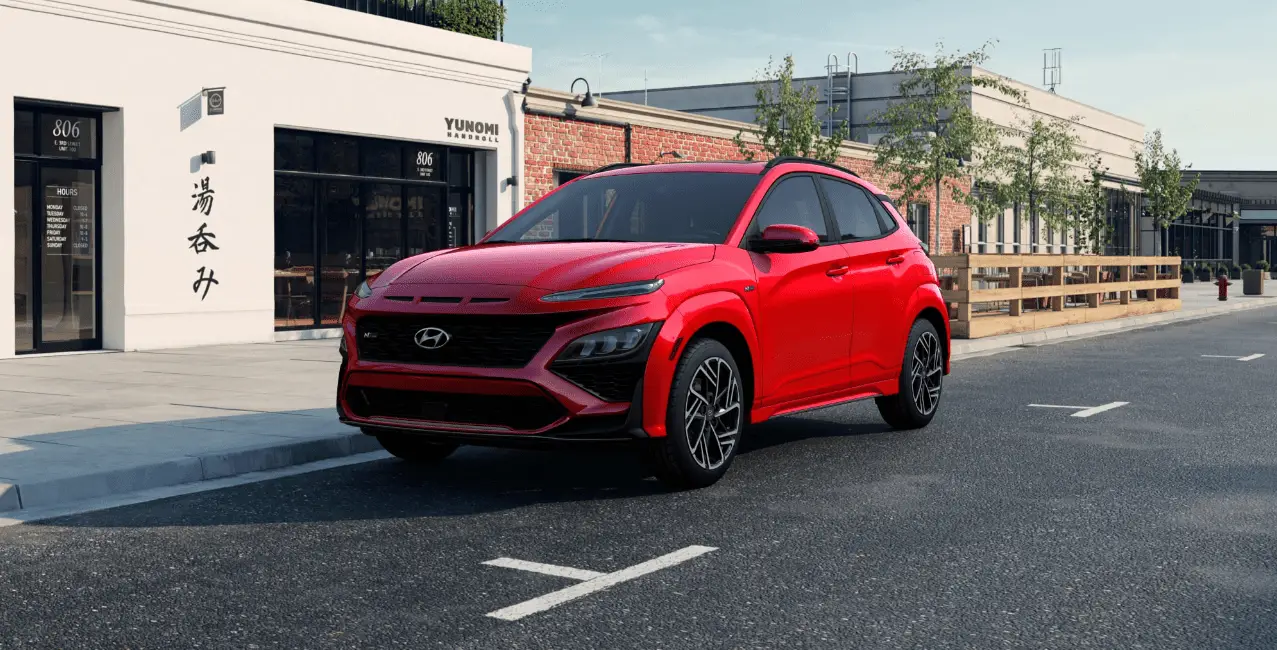Hyundai Kona 2023 Air Bag – Supplemental Restraint System
The Air Bag Supplemental Restraint System (SRS) on the Hyundai Kona 2023 is a cutting-edge safety technology that has been painstakingly created to offer vital protection to car occupants in the case of an accident. With a wide range of airbags—including curtain, side-impact, and front airbags—and seat belt pretensioners, the SRS is ready to improve occupant safety by reducing impact forces during collisions. The technology, which is outfitted with advanced sensors to evaluate the impact of an impact, lowers the risk of injury to passengers by activating seat belt pretensioners and deploying the proper airbags. The SRS on the Hyundai Kona 2023 highlights the dedication to safety and is an essential part of the car’s defense system.
2023 Hyundai KONA Specs, Price, Features, Milage (Brochure)
Air Bag – Supplemental Restraint System
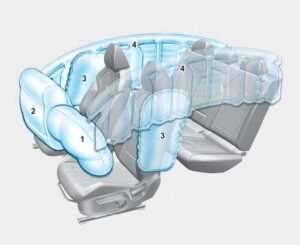
The actual airbags in the vehicle may differ from the illustration
- Driver’s front airbag
- Passenger’s front airbag
- Side airbag
- Curtain airbag
This vehicle is equipped with an Advanced Supplemental Air Bag System for the driver’s seat and front passenger’s seats. The front airbags are designed to supplement the three-point seat belts. For these airbags to provide protection, the seat belts must be worn at all times when driving. You can be severely injured or killed in an accident if you are not wearing a seat belt. Airbags are designed to supplement seat belts but do not replace them. Also, airbags are not designed to deploy in every collision. In some accidents, the seat belts are the only restraint protecting you.
WARNING
AIRBAG SAFETY PRECAUTIONS
ALWAYS use seat belts and child restraints – every trip, every time, everyone! Even with airbags, you can be seriously injured or killed in a collision if you are improperly belted or not wearing your seat belt when the airbag inflates. NEVER place a child in any child restraint or booster seat in the front passenger seat. An inflating air bag could forcefully strike the infant or child causing serious or fatal injuries. ABC – Always Buckle Children under age 13 in the back seat. It is the safest place for children of any age to ride. If a child age 13 or older must be seated in the front seat, he or she must be properly belted and the seat should be moved as far back as possible. All occupants should sit upright with the seatback in an upright position, centered on the seat cushion with their seat belt on, legs comfortably extended and their feet on the floor until the vehicle is parked and is turned off. If an occupant is out of position during an accident, the rapidly deploying air bag may forcefully contact the occupant causing serious or fatal injuries. You and your passengers should never sit or lean unnecessarily close to the airbags or lean against the door or center console. Move your seat as far back as possible from front airbags, while still maintaining control of the vehicle. The U.S. National Highway Traffic Safety Administration (NHTSA) recommends that drivers allow at least 10 inches (25 cm) between the center of the steering wheel and the chest.
Where are the Air Bags?
Driver’s and passenger’s front airbags
Your vehicle is equipped with an Advanced Supplemental Restraint System (SRS) and lap/shoulder belts at both the driver and passenger seating positions. The SRS consists of air bags which are located in the center of the steering wheel, in the driver’s side lower crash pad below the steering wheel column, and the passenger’s side front panel pad above the glove box. The airbags are labeled with the letters “AIR BAG” embossed on the pad covers.
 The purpose of the SRS is to provide the vehicle’s driver and front passengers with additional protection than that offered by the seat belt system alone. The SRS uses sensors to gather information about the driver’s and front passenger’s seat belt usage and impact severity. The seat belt buckle sensors determine if the driver and front passenger’s seat belts are fastened. These sensors provide the ability to control the SRS deployment based on whether or not the seat belts are fastened, and how severe the impact is. The advanced SRS offers the ability to control the airbag inflation within two levels. A first-stage level is provided for moderate-severity impacts. A second stage level is provided for more severe impacts. According to the impact severity, and seat belt usage, the SRS Control Module (SRSCM) controls the air bag inflation. Failure to properly wear seat belts can increase the risk or severity of injury in an accident.
The purpose of the SRS is to provide the vehicle’s driver and front passengers with additional protection than that offered by the seat belt system alone. The SRS uses sensors to gather information about the driver’s and front passenger’s seat belt usage and impact severity. The seat belt buckle sensors determine if the driver and front passenger’s seat belts are fastened. These sensors provide the ability to control the SRS deployment based on whether or not the seat belts are fastened, and how severe the impact is. The advanced SRS offers the ability to control the airbag inflation within two levels. A first-stage level is provided for moderate-severity impacts. A second stage level is provided for more severe impacts. According to the impact severity, and seat belt usage, the SRS Control Module (SRSCM) controls the air bag inflation. Failure to properly wear seat belts can increase the risk or severity of injury in an accident.
WARNING
To reduce the risk of serious injury or death from inflating front airbags, take the following precautions:
- Seat belts must be worn at all times to help keep occupants positioned properly
- Move your seat as far back as possible from front airbags, while still maintaining control of the vehicle.
- Never lean against the door or center console.
- Do not allow the front passenger to place their feet or legs on the dashboard.
- No objects (such as crash pad cover, cellular phone holder, cup holder, air fresheners or stickers) should be placed over or near the airbag modules on the steering wheel, instrument panel, windshield glass, and the front passenger panel above the glove box. Such objects could cause harm if the vehicle is in a crash severe enough to cause the airbags to deploy.
Side airbags
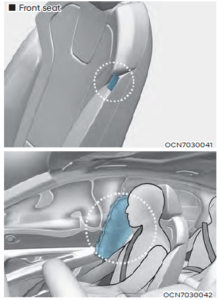
Your vehicle is equipped with a side air bag in each front seat. The purpose of the airbag is to provide the vehicle’s driver and the front passenger with additional protection than that offered by the seat belt alone.
The side airbags are designed to deploy only during certain side-impact collisions, depending on the crash severity. The side and curtain airbags on both sides of the vehicle may deploy if a rollover or possible rollover is detected. For vehicles equipped with a rollover sensor, the side airbags and pre-tensioners on both sides of the vehicle may deploy if a rollover or possible rollover is detected. However, the side air bags are not designed to deploy in all side impact or rollover situations.
WARNING
To reduce the risk of serious injury or death from an inflating side airbag, take the following precautions:
- Seat belts must be worn at all times to help keep occupants positioned properly.
- Do not allow passengers to lean their heads or bodies onto doors, put their arms on the doors, stretch their arms out of the window, or place objects between the doors and seats.
- Hold the steering wheel at the 9
- Do not use any accessory seat covers. This could reduce or prevent the effectiveness of the system.
- Do not place any objects over the air bag or between the air bag and yourself. Also, do not attach any objects around the area where the air bag inflates such as the door, side door glass, and front, and rear pillar.
- Do not place any objects between the door and the seat. They may become dangerous projectiles if the side airbag inflates.
- Do not install any accessories on the side or near the side airbags.
- Do not put any objects between the side airbag label and the seat cushion. It could cause harm if the vehicle is in a crash severe enough to cause the airbags to deploy.
- Do not cause impact to the doors when the ignition switch button is in the ON position as this may cause the side airbags to inflate.
- If the seat or seat cover is damaged, have the vehicle checked and repaired by an authorized HYUNDAI dealer.
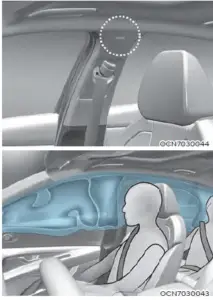
Curtain airbags are located along both sides of the roof rails above the front and rear doors.
They are designed to help protect the heads of the front seat occupants and the rear outboard seat occupants in certain side impact collisions.
The curtain airbags are designed to deploy during certain side impact collisions, depending on the crash severity.
The side and curtain airbags on both sides of the vehicle may deploy if a rollover or possible rollover is detected.
The curtain air bags are not designed to deploy in all side impact or rollover situations.
WARNING
To reduce the risk of serious injury or death from an inflating curtain airbag, take the following precautions:
- All seat occupants must wear seat belts at all times to help keep occupants positioned properly.
- Properly secure child restraints as far away from the door as possible.
- Do not place any objects over the airbag. Also, do not attach any objects around the area where the airbag inflates such as the door, side door glass, front and rear pillar, or roof side rail.
- Do not hang other objects except clothes, especially hard or breakable objects. In an accident, it may cause vehicle damage or personal injury.
- Do not allow passengers to lean their heads or bodies onto doors, put their arms on the doors, stretch their arms out of the window, or place objects between the doors and seats.
- Do not attempt to open or repair the side curtain airbags yourself. If necessary, have the airbag inspected by an authorized HYUNDAI dealer?
How Does the Air Bag System Operate?
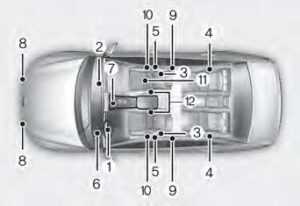
The SRS consists of the following components:
- Driver’s front airbag module
- Passenger’s front airbag module
- Side airbag modules (front)
- Curtain airbag modules
- Retractor pre-tensioner assemblies
- Airbag warning light
- SRS control module (SRSCM) /Rollover sensor
- Front impact sensors
- Side impact sensors (acceleration)
- Side impact sensors (pressure)
- Occupant classification system
- Driver’s and front passenger’s seat belt buckle sensors
The SRSCM (Supplemental Restraint System Control Module) continually monitors all SRS components while the Engine Start/Stop button is in the ON position or approximately 3 minutes after the ignition is off to determine if a crash impact is severe enough to require air bag deployment or pre-tensioner seat belt deployment.
SRS warning light
The SRS (Supplement Restraint System) air bag warning light on the instrument panel displays the airbag symbol depicted in the illustration. The system checks the airbag electrical system for malfunctions. The light indicates that there is a potential malfunction with your air bag system, which could include your side and curtain airbags used for rollover protection.
WARNING
If your SRS malfunctions, the airbag may not inflate properly during an accident, increasing the risk of serious injury or death.
If any of the following conditions occur, your SRS is malfunctioning:
- The light does not turn on for approximately three to six seconds when the Engine Start/Stop button is in the ON position.
- The light stays on after illuminating for approximately three to six seconds.
- The light comes on while the vehicle is in motion.
- The light blinks when the engine is running.
Have an authorized HYUNDAI dealer inspect the SRS as soon as possible if any of these conditions occur. During a frontal collision, sensors will detect the vehicle’s deceleration. If the rate of deceleration is high enough, the control unit will inflate the front airbags. The front airbags help protect the driver and front passenger by responding to frontal impacts in which seat belts alone cannot provide adequate restraint. When needed, the side airbags help provide protection in the event of a side impact or rollover.
- Air bags are activated (able to inflate if necessary) when the Engine Start/Stop button is in the ON position or approximately within 3 minutes after ignition off.
- Airbags inflate in the event of certain frontal or side collisions to help protect the occupants from serious physical injury.
- Generally, airbags are designed to inflate based on the severity of a collision, its direction, etc. These two factors determine whether the sensors produce an electronic deployment/inflation signal.
- The front airbags will completely inflate and deflate in an instant. It is virtually impossible for you to see the airbags inflate during an accident. It is much more likely that you will simply see the deflated airbags hanging out of their storage compartments after the collision.
- In addition to inflating in certain side collisions, vehicles equipped with a rollover sensor, and side and curtain airbags will inflate if the sensing system detects a rollover.
When a rollover is detected, side and curtain airbags will remain inflated longer to help provide protection from ejection, especially when used in conjunction with seat belts. - To help provide protection, the airbags must inflate rapidly. The speed of airbag inflation is a consequence of the extremely short time in which to inflate the airbag between the occupant and the vehicle structures before the occupant impacts those structures. This speed of inflation reduces the risk of serious or life-threatening injuries and is thus a necessary part of airbag design.
However, rapid airbag inflation can also cause injuries which can include facial abrasions, bruises, and broken bones because the inflation speed also causes the airbags to expand with a great deal of force. - There are even circumstances under which contact with the airbag can cause fatal injuries, especially if the occupant is positioned excessively close to the air bag.
You can take steps to help reduce the risk of being injured by an inflating airbag. The greatest risk is sitting too close to the airbag. An airbag needs about 10 inches (25 cm) of space to inflate. NHTSA recommends that drivers allow at least 10 inches (25 cm) between the center of the steering wheel and the chest.
WARNING
To reduce the risk of serious injury or death from an inflating air bag, take the following precautions:
- NEVER place a child restraint in the front passenger seat.
- Always properly restrain children under age 13 in the rear seats of the vehicle.
- Adjust the front passenger’s and driver’s seats as far to the rear as possible while allowing you to maintain full control of the vehicle.
- Hold the steering wheel with hands at the 9 o’clock and 3 o’clock positions.
- NEVER place anything or anyone between the airbag and the seat occupant.
to place their feet or legs on the dashboard.

When the SRSCM detects a sufficiently severe impact to the front of the vehicle, it will automatically deploy the front airbags.
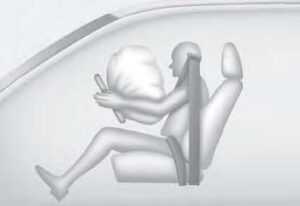
Upon deployment, tear seams molded directly into the pad covers will separate under pressure from the expansion of the airbags. Further opening of the covers allows full inflation of the airbags. A fully inflated air bag, in combination with a properly worn seat belt, slows the driver or the front passenger’s forward motion, reducing the risk of head and chest injury.
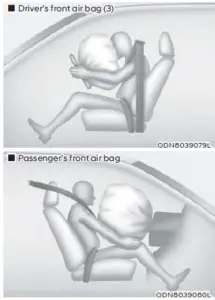
After complete inflation, the air bag immediately starts deflating, enabling the driver to maintain forward visibility and the ability to steer or operate other controls.
WARNING
To prevent objects from becoming dangerous projectiles when the passenger’s airbag inflates:
- Do not install or place any objects (drink holder, CD holder, stickers, etc.) on the front passenger’s panel above the glove box where the passenger’s airbag is located.
- Do not install a container of liquid air freshener near the instrument cluster or on the instrument panel surface.
What to Expect After an Air Bag Inflates
After a frontal or side air bag inflates, it will deflate very quickly. Airbag inflation will not prevent the driver from seeing out of the windshield or being able to steer. Curtain air bags may remain partially inflated for some time after they deploy.
WARNING
After an air bag inflates, take the following precautions:
- Open your windows and doors as soon as possible after impact to reduce prolonged exposure to the smoke and powder released by the inflating airbag.
- Do not touch the air bag storage area’s internal components immediately after an air bag has inflated. The parts that come into contact with an inflating airbag may be very hot.
- Always wash exposed skin areas thoroughly with cold water and mild soap.
- Always have an authorized HYUNDAI dealer replace the airbag immediately after deployment. Airbags are designed to be used only once.
Noise and smoke from inflating airbags
When the airbags inflate, they make a loud noise and may produce smoke and powder in the air inside of the vehicle. This is normal and is a result of the ignition of the airbag inflator. After the airbag inflates, you may feel substantial discomfort in breathing because of the contact of your chest with both the seat belt and the airbag, as well as from breathing the smoke and powder. The powder may aggravate asthma in some people. If you experience breathing problems after an airbag deployment, seek medical attention immediately. Though the smoke and powder are nontoxic, they may cause irritation to the skin, eyes, nose, throat, etc. If this is the case, wash and rinse with cold water immediately and seek medical attention if the symptoms persist.
Occupant Classification System (OCS)
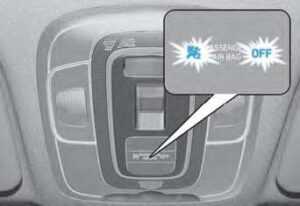
Your vehicle is equipped with an Occupant Classification System (OCS) in the front passenger’s seat.
Main components of the Occupant Classification System
- A detection device is located within the front passenger seat cushion.
- Electronic system to help determine whether the passenger airbag systems should be activated or deactivated.
- An indicator light located on the overhead console which illuminates the words “PASSENGER AIR BAG OFF” indicating the front passenger airbag system is deactivated.
- The overhead console airbag indicator light is interconnected with the OCS.
The OCS is designed to help detect the presence of a properly-seated
front passenger and determine if the passenger’s front airbag should be enabled (may inflate) or not. The purpose is to help reduce the risk of injury or death from an inflating airbag to certain front passenger seat occupants, such as children, by requiring the airbag to be automatically turned OFF.
For example, if a child restraint of the type specified in the regulations is on the seat, the occupant classification sensor can detect it and cause the airbag to turn OFF. Front passenger seat adult occupants who are properly seated and wearing the seat belt properly, should not cause the passenger airbag to be automatically turned OFF. For small adults it may be turned OFF, however, if the occupant does not sit in the seat properly (for example, by not sitting upright, by sitting on the edge of the seat, or by otherwise being out of position), this could cause the sensor to turn the airbag OFF. You will find the “PASSENGER AIR BAG OFF” indicator on the overhead console. This system detects conditions 1-4 in the following table and activates or deactivates the front passenger airbag based on these conditions. Always be sure that you and all vehicle occupants are seated properly and wearing the seat belt properly for the most effective protection by the airbag and the seat belt. Never install a Child Restraint System in the front passenger’s seat. If you should install a CRS (Child Restraint System), use a forward-facing CRS with a 3-point ALR safety seat belt and adjust the front passenger’s seat as far to the rear as possible. If the PASSENGER AIR BAG “OFF” indicator is OFF after a CRS (Child Restraint System) is equipped, the front passenger’s airbag is operating so you should install the CRS in the rear seats of the vehicle immediately.
The OCS may not function properly if the passenger takes actions that can affect the classification system. These include:
- Failing to sit in an upright position.
- Leaning against the door or center console.
- Sitting towards the sides of the front of the seat.
- Putting their legs on the dashboard or resting them on other locations reduce the passenger weight on the front seat.
- Wearing the seat belt improperly.
- Reclining the seatback.
- Wearing thick cloth like ski wear or hip protection wear.
- Putting an additional thick cushion on the seat.
- Putting electrical devices (for example, notebook, satellite radio) on the seat with inverter charging.
Condition and operation in the front passenger Occupant Classification System
|
Condition detected by the occupant classification system |
Indicator/Warning light | Devices | |
|
“PASSENGER AIR BAG OFF” indicator light |
SRS warning light | Front passenger air bag | |
| 1. Adult *1 | Off | Off | Activated |
|
2. Infant *2 or child restraint system with 12 months old *3 *4 |
On |
Off |
Deactivated |
| 3. Unoccupied | On | Off | Deactivated |
| 4. Malfunction in the system | Off | On | Activated |
- The system judges a person of adult size as an adult. When a smaller adult sits in the front passenger seat, the system may recognize him/her as a child depending on his/her physique and posture.
- Do not allow children to ride in the front passenger seat. When a larger child who has outgrown a child restraint system sits in the front passenger seat, the system may recognize him/her as an adult depending upon his/her physique or sitting position.
- Never install a child restraint system on the front passenger seat.
- The PASSENGER AIR BAG “OFF” indicator may turn on or off when a child above 12 months to 12 years old (with or without a child restraint system) sits in the front passenger seat. This is a normal condition.
WARNING
Riding in an improper position or placing weight on the front passenger’s seat when it is unoccupied by a passenger adversely affects the OCS. To reduce the risk of serious injury or death:
 NEVER put a heavy load in the front seat or seatback pocket, or hang any items on the front passenger seat.
NEVER put a heavy load in the front seat or seatback pocket, or hang any items on the front passenger seat.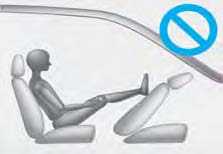
- NEVER place your feet on the front passenger seatback.
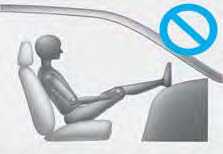
- NEVER sit with your hips shifted towards the front of the seat.

- NEVER ride with the seatback reclined when the vehicle is moving.

- NEVER place your feet or legs on the dashboard.
- NEVER lean on the door or center console or sit on one side of the front passenger seat.
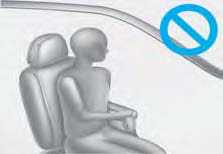
- Do not sit on the passenger seat wearing heavily padded clothes such as ski wear and hip protectors.
- Do not use car seat accessories such as thick blankets and cushions that cover up the car seat surface.
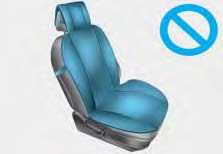
- Do not use car seat accessories such as thick blankets and cushions that cover up the car seat surface.
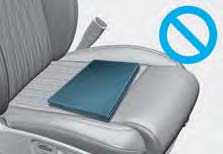
- Do not place electronic devices such as laptops, DVD players, or conductive materials such as water bottles on the passenger seat.
- Do not use electronic devices such as laptops and satellite radios which use inverter chargers.
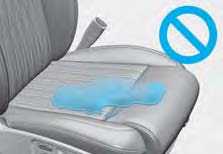
-
- If a large amount of liquid has been spilled on the passenger seat, the airbag warning light may illuminate or malfunction.
- Therefore, make sure the seat has been completely dried before driving the vehicle.
- Do not place sharp objects on the front passenger seat. These may damage the occupant detection system if they puncture the seat cushion.
- Do not place any items under the front passenger seat.
- When changing or replacing the seat or seat cover, use the original items only.
The OCS has been developed based on using original HYUNDAI car seats only. Altering or changing the authentic parts may result in system malfunction and increase the risk of injury when in a collision. Any of the above could interfere with the proper operation of the OCS sensor thereby increasing the risk of an injury in an accident.
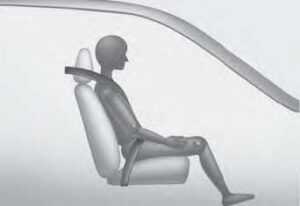 Proper seated position for OCS
Proper seated position for OCS
If the “PASSENGER AIR BAG OFF” indicator is on when an adult is seated in the front passenger seat, place the Engine Start/Stop button in the OFF position and ask the passenger to sit properly (sitting upright with the seat back in an upright position, centered on the seat cushion with their seat belt on, legs comfortably extended and their feet on the floor). Restart the engine and have the person remain in that position. This will allow the system to detect the person and enable the passenger airbag. If the “PASSENGER AIR BAG OFF” indicator is still on, ask the passenger to move to the rear seat.
WARNING
NEVER allow an adult passenger to ride in the front passenger seat when the “PASSENGER AIR BAG OFF” indicator is illuminated. During a collision, the airbag will not inflate if the indicator is illuminated. Have your passengers reposition themselves in the seat. If the “PASSENGER AIR BAG OFF” indicator remains illuminated after the passenger repositions themselves properly and the vehicle is restarted, have the passenger move to the rear seat because the airbag will not inflate.
NOTICE
The “PASSENGER AIR BAG OFF” indicator generally illuminates for approximately 4 seconds after the Engine Start/Stop button is in the ON position or after the engine is started. However, if the ignition switch or Engine Start/Stop button is turned to the ON position within 3 minutes after ignition OFF, the indicator does not illuminate. If the front passenger seat is occupied, the OCS will then classify the front passenger after several more seconds.
Do Not Install a Child Restraint in the Front Passenger’s Seat

Even though your vehicle is equipped with the OCS, never install a child restraint in the front passenger’s seat. An inflating air bag can forcefully strike a child or child restraint resulting in serious or fatal injury.
WARNING
NEVER place a rear-facing or front-facing child restraint in the front passenger’s seat of the vehicle. An inflating frontal air bag could forcefully strike a child resulting in serious injury or death. Always properly restrain children in an appropriate child restraint in the rear seat of the vehicle.
Why Didn’t My Air Bag Go Off in a Collision?
Airbags are not designed to inflate in every collision. There are certain types of accidents in which the airbag would not be expected to provide additional protection. These include rear impacts, second or third collisions in multiple-impact accidents, as well as low-speed impacts. Damage to the vehicle indicates collision energy absorption and is not an indicator of whether or not an airbag should have inflated.
WARNING
To reduce the risk of an airbag deploying unexpectedly and causing serious injury or death:
- Do not hit or allow any objects to impact the locations where airbags or sensors are installed.
- Do not perform maintenance on or around the airbag sensors. If the location or angle of the sensors is altered, the airbags may deploy when they should not or may not deploy when they should.
- Do not install bumper guards or replace the bumper with non-genuine HYUNDAI parts. This may adversely affect the collision and airbag deployment performance.
- Place the ignition switch in the LOCK/OFF or ACC position when the vehicle is being towed to prevent inadvertent airbag deployment.
- Have all airbag repairs performed by an authorized HYUNDAI dealer.
Airbag collision sensors


- SRS control module/Rollover sensor
- Front impact sensors
- Side impact sensors (acceleration)
- Side impact sensors (pressure)
Airbag inflation conditions

Front airbags
Front air bags are designed to inflate in a frontal collision depending on the severity of impact of the front collision.
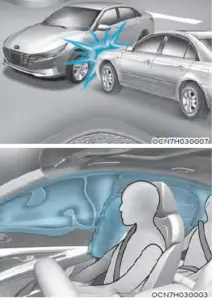
Side and curtain airbags
Side and curtain airbags are designed to inflate when an impact is detected by side collision sensors depending on the severity of impact resulting from a side impact collision. Although the driver’s and front passenger’s airbags are designed to inflate only in frontal collisions, they also may inflate in other types of collisions if the front impact sensors detect a sufficient impact. Side and curtain airbags are designed to inflate only in side impact collisions or rollover situations, but they may inflate in other collisions if the side impact sensors detect a sufficient impact. If the vehicle chassis is impacted by bumps or objects on unimproved roads, the airbags may deploy. Drive carefully on unimproved roads or on surfaces not designed for vehicle traffic to prevent unintended air bag deployment.
Air bag non-inflation conditions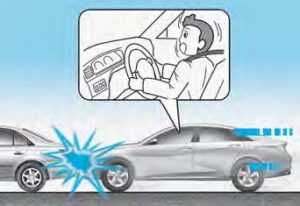
In certain low-speed collisions, the airbags may not deploy. The airbags are designed not to deploy in such cases because they may not provide benefits beyond the protection of the seat belts.
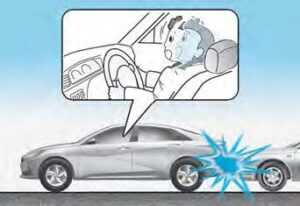
Front airbags are not designed to inflate in rear collisions, because occupants are moved backward by the force of the impact. In this case, inflated airbags would not provide any additional benefit.
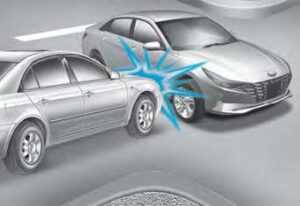
Front airbags may not inflate in side impact collisions, because occupants move in the direction of the collision, and thus in side impacts, front airbag deployment would not provide additional occupant protection. However, side and curtain airbags may inflate depending on the severity of the impact.
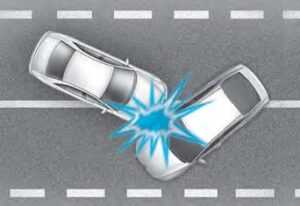
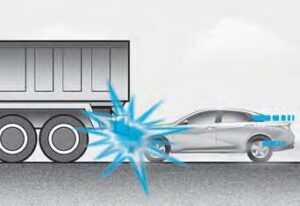
Just before impact, drivers often brake heavily. Such heavy braking lowers the front portion of the vehicle causing it to “ride” under a vehicle with a higher ground clearance. Airbags may not inflate in this “underride” situation because deceleration forces that are detected by sensors may be significantly reduced by such “underride” collisions.
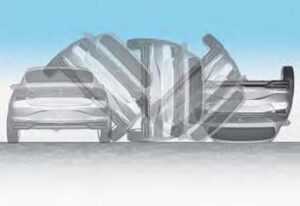
Front airbags may not inflate in rollover accidents because airbag deployment may not provide protection to the occupants. However, side and curtain airbags may inflate when the vehicle is rolled over by a side-impact collision.
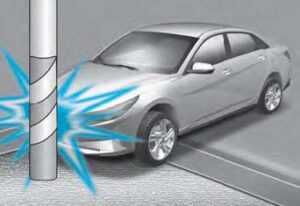
Airbags may not inflate if the vehicle collides with objects such as utility poles or trees, where the point of impact is concentrated and the collision energy is absorbed by the vehicle structure.
SRS Care
The SRS is virtually maintenance-free and there are no parts you can safely service by yourself. If the SRS airbag warning light does not illuminate when the ignition switch is in the ON position, or continuously remains on, have your vehicle immediately inspected by an authorized HYUNDAI dealer. Any work on the SRS system, such as removing, installing, repairing, or any work on the steering wheel, the front passenger’s panel, front seats, and roof rails must be performed by an authorized HYUNDAI dealer. Improper handling of the SRS system may result in serious personal injury.
WARNING
To reduce the risk of serious injury or death, take the following precautions:
- Do not attempt to modify or disconnect the SRS components or wiring, including the addition of any kind of badges to the pad covers or modifications to the body structure.
- Do not place objects over or near the airbag modules on the steering wheel, instrument panel, or the front passenger’s panel above the glove box. proper deployment of the system.
- Always have inflated airbags replaced by an authorized HYUNDAI dealer.
- If components of the airbag system must be discarded, or if the vehicle must be scrapped, certain safety precautions must be observed. Consult an authorized HYUNDAI dealer for the necessary information. Failure to follow these precautions could increase the risk of personal injury.
Additional Safety Precautions
Passengers should not move out of or change seats while the vehicle is moving. A passenger who is not wearing a seat belt during a crash or emergency stop can be thrown against the inside of the vehicle, against other occupants, or be ejected from the vehicle. Do not use any accessories on seat belts. Devices claiming to improve occupant comfort or reposition the seat belt can reduce the protection provided by the seat belt and increase the chance of serious injury in a crash. Do not modify the front seats. Modification of the front seats could interfere with the operation of the supplemental restraint system sensing components or side airbags. Do not place items under the front seats. Placing items under the front seats could interfere with the operation of the supplemental restraint system sensing components and wiring harnesses. Do not cause an impact to the doors. Impact on the doors, when the Engine Start/Stop button is in the ON position, may cause the airbags to inflate. Modifications to accommodate disabilities. If you require modification to your vehicle to accommodate a disability, contact the HYUNDAI Customer Connect Center at 800-633-5151. Adding equipment to or modifying your air bag-equipped vehicle If you modify your vehicle by changing your vehicle’s frame, bumper system, front end or side sheet metal or ride height, this may affect the operation of your vehicle’s air bag system.
Air Bag Warning Labels

Air bag warning labels, required by the U.S. National Highway Traffic Safety Administration (NHTSA), are attached to alert the driver and passengers of potential risks of the air bag system. Be sure to read all of the information about the airbags that are installed on your vehicle in this Owner’s Manual.
FAQ
The SRS is a safety feature that includes airbags and seat belt pretensioners designed to provide additional protection in the event of a collision.
The number of airbags may vary by trim level, but it typically includes front airbags, side-impact airbags, and curtain airbags.
Yes, the 2023 Hyundai Kona typically has airbags for both the driver and front passenger.
Yes, the Kona usually includes side curtain airbags to provide protection for rear passengers in the event of a side collision.
Seat belt pretensioners are designed to tighten the seat belts in a collision, reducing the slack and helping to secure occupants more firmly in their seats.
Front airbags deploy in the event of a frontal collision, providing a cushion to protect the driver and front passenger from impact with the steering wheel, dashboard, or windshield.
Side-impact airbags deploy in the event of a side collision to protect the occupants from impact with the door or other objects.
Curtain airbags are typically deployed during a side collision to protect the heads of occupants and help prevent injuries from glass or debris.
Yes, the 2023 Hyundai Kona typically has sensors that detect the severity of a collision and trigger the deployment of the appropriate airbags and pretensioners.
Some models may allow the front passenger airbag to be manually turned off for situations when a child or rear-facing child seat is in use.
Yes, it’s important to follow safety guidelines, including sitting properly with your hands on the steering wheel, to maximize the effectiveness of airbags.
If the airbags deploy, it’s important to seek medical attention and have the vehicle inspected and repaired by a qualified technician.
Hyundai typically offers a warranty that covers the SRS for a certain period or mileage, but coverage may vary by region and specific trim level.
Yes, modifying the vehicle with aftermarket parts or accessories may affect the proper functioning of the SRS and should be done with caution.
You can refer to the owner’s manual and the Hyundai website for detailed information about the SRS and its operation.
Useful Link
View Full User Guide: Hyundai Kona 2023 User Guide
Download Manuals: https://owners.hyundaiusa.com/us/en/resources/manuals-warranties.html
2023 Hyundai KONA Specs, Price, Features, Milage (Brochure)

